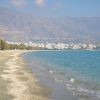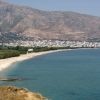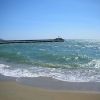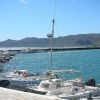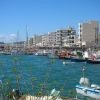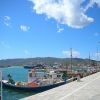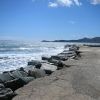KARYSTOS DITIKI (WEST) or RIGIA, GALIDA, KREMALA beach in KARYSTOS (SOUTH EVIA)
It starts from the western edge of the harbour, in the town centre, and stretches westwards for about 2 km. The first part is the west beach of Karystos, the middle part is called “Gallida” and the western part is “Rigia”, named after the river that discharges there, forming an interesting biotope.
The beach faces southwards. Parallel to the beach, throughout its whole length, runs the town’s coastal road which offers direct access to it. The road is separated from the beach by a line of “armirikia”
(Tamarisk trees).
Along the most frequented parts of the beach there are changing cabins and showers.
On the east part of the beach there are deckchairs with umbrellas set up by the cafés along the front. That part of the beach is called Kremala.
It attracts a substantial number of visitors who enjoy the services offered by the various waterfront businesses (refreshments, drinks and food).
All along this stretch of beach (300m) the water is clear, shallow and warm with a sandy sea-bottom, which makes it safe for young children.
Immediately to the west the beach is still sandy, apart from a stretch of about 250m of rocky sea-bed which is suitable for snorkelling and amateur underwater fishing. About 7-8m off the beach the sea-bed is sandy again.
The tamarisk trees bordering the northern side of the beach offer good shade. There are also permanent straw umbrellas all along the beach. At the west edge of this part of the beach there is a slipway for the launching of small leisure boats.
From there starts the part of the beach called “Gallida”, which stretches westwards for about 750 m. The beach is sandy with calm shallow waters, suitable for the whole family.
The tamarisk trees and the umbrellas offer good shade. There is also a cantina and a small river that flows parts of the year, forming an interesting little biotope. It is accessed directly from the main road.
The westernmost part of the beach is called Rigia.
This is also a sandy beach (about 550 long), with sandy sea-bed and rather shallow waters. What makes this part of the coast distinctive is that here the row of tamarisk trees separates the beach from a small biotope of about 1000 m2 on its north side. This is the mouth of the river Rigia and the low-lying vegetation that grows here consists mainly of bamboos and reeds. This area floods during the winter rains until late in the spring and forms a natural habitat for various species of migratory swamp birds. Various kinds of fish, mainly salt water fish that swim upstream from the sea, are also found in the river.
In the western extremity of the beach we find 2-3 picturesque small beaches separated from the rest by high rock formations, which also offer good shade. The extensive sandy seabed in this part of the bay of Karystos is a great biotope that shelters a large variety of shellfish which, in their turn, provide food for octopi and seabed fish. Hence, the area attracts the attention of amateur fishermen and snorkellers
The beach faces southwards. Parallel to the beach, throughout its whole length, runs the town’s coastal road which offers direct access to it. The road is separated from the beach by a line of “armirikia”
(Tamarisk trees).
Along the most frequented parts of the beach there are changing cabins and showers.
On the east part of the beach there are deckchairs with umbrellas set up by the cafés along the front. That part of the beach is called Kremala.
It attracts a substantial number of visitors who enjoy the services offered by the various waterfront businesses (refreshments, drinks and food).
All along this stretch of beach (300m) the water is clear, shallow and warm with a sandy sea-bottom, which makes it safe for young children.
Immediately to the west the beach is still sandy, apart from a stretch of about 250m of rocky sea-bed which is suitable for snorkelling and amateur underwater fishing. About 7-8m off the beach the sea-bed is sandy again.
The tamarisk trees bordering the northern side of the beach offer good shade. There are also permanent straw umbrellas all along the beach. At the west edge of this part of the beach there is a slipway for the launching of small leisure boats.
From there starts the part of the beach called “Gallida”, which stretches westwards for about 750 m. The beach is sandy with calm shallow waters, suitable for the whole family.
The tamarisk trees and the umbrellas offer good shade. There is also a cantina and a small river that flows parts of the year, forming an interesting little biotope. It is accessed directly from the main road.
The westernmost part of the beach is called Rigia.
This is also a sandy beach (about 550 long), with sandy sea-bed and rather shallow waters. What makes this part of the coast distinctive is that here the row of tamarisk trees separates the beach from a small biotope of about 1000 m2 on its north side. This is the mouth of the river Rigia and the low-lying vegetation that grows here consists mainly of bamboos and reeds. This area floods during the winter rains until late in the spring and forms a natural habitat for various species of migratory swamp birds. Various kinds of fish, mainly salt water fish that swim upstream from the sea, are also found in the river.
In the western extremity of the beach we find 2-3 picturesque small beaches separated from the rest by high rock formations, which also offer good shade. The extensive sandy seabed in this part of the bay of Karystos is a great biotope that shelters a large variety of shellfish which, in their turn, provide food for octopi and seabed fish. Hence, the area attracts the attention of amateur fishermen and snorkellers
